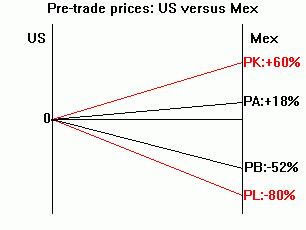II.
A closer look at international trade
A. Factor endowments
and international trade
3. The Stolper-Samuelson
(SS) theorem (finish
Worksheet
Results of example: before
trade:
PK in Mexico is 60% higher than in US (+60%)
PL in Mexico is 80% lower than in US (-80%)
PA in Mexico is
18% higher than in US (+18%)
PB in Mexico is 52% lower than in US (-52%)
General conclusions from the Four Fingers diagram
- Higher PK in Mex raises Mex product prices,
especially for A which relies a lot on K.
- Lower PL in PL in Mex lowers product prices,
especially for B which relies a lot on L.
- Why can't PA be > 60% higher in
Mex?
- Why can't PB be > 80% lower in
Mex?
- The price changes for all
outputs lie between the input price changes since
all goods use some of both inputs in production.
- Every product's price can be
ranked: The more capital-intensive it is, the closer its price will
be to PK.
|
 |
The move to free trade is not so much a
race to the bottom. It's more like a race to the middle. Competition makes the
difference.
With trade: As globalization occurs,
output and input prices converge, and we can rank all four price changes in both
countries
Visually, the slope of each price line shows its rate of
change
|
US: |
%DPK > %DPA > %DPB
> %DPL |
|
|
|
|
|
|
|
|
|
Mex: |
%DPL > %DPB > %DPA
> %DPK |
In the US:
(1) the purchasing power of K rises relative to both goods =>
the real price of K rises.
(2) the purchasing power of L falls relative to both
goods => the real price of L falls.
The opposite occurs in Mexico
The Stolper-Samuelson (SS) theorem:
free trade raises the real income of a country's abundant factor and lowers the real
income of the country's scarce factor.
Evidence:
mainly from the US:
trade liberalization -->
for each $1 of trade gains:
K gains $6 and L loses $5. (NBER,
Spr.92: Dani Rodrik)
? What about you personally--what
does the model imply about how you should feel about free trade, anticipating graduation
and entering the L-mkt?
? What should we do about it?
4.
Real world applications
(1) Import-substitution industrialization (ISI)
=> low-income
countries try to develop by promoting their import industries
Why?
avoid dependency
Tried most in Latin America
ISI
=> A labor-abundant country tries to
produce capital-intensive goods
HO and ISI worksheet
Results of ISI:
lower national income
lower wages
ISI imposes an upfront cost on
countries that use it
LDCs typically have relatively little capital to work with in
the first place.
ISI then takes that scarce capital and concentrates it in
K-intensive industries.
That leaves even less capital available for the rest of the
economy to use, reducing the productivity and wages of workers, especially
workers outside of the favored industries.
(2) Export-Led Industrialization (ELI)
| Ex: consider what happens as a country grows, accumulating more K. |
 |
| |
|
Example: Japan
| Real per capita GDP, 2000
dollars: |
| |
1950 |
2000 |
2000/1950 |
| U.S. |
11,261 |
34,445 |
3.1 |
| Japan |
2,400 |
25,070 |
10.4 |
| US/Japan |
4.7 |
1.4 |
|
Potential path to
development:
Step 1: Specialize according to your comparative advantage to
maximize your current income.
Step 2: Use your income to increase your physical and human
capital.
Result: Export-Led Industrialization can help change your comparative advantage over time.
So, HO trade
does not have to lock countries into a disadvantageous equilibrium

